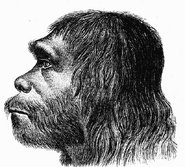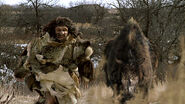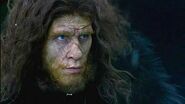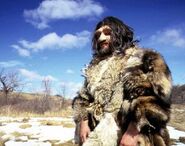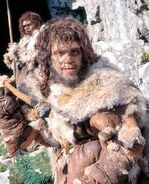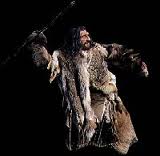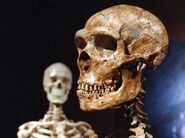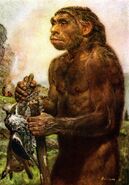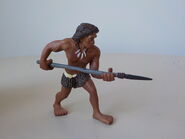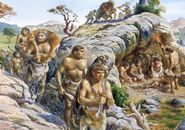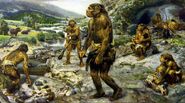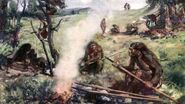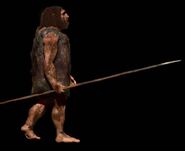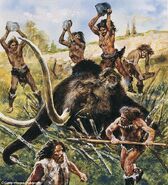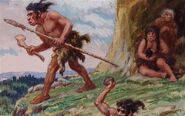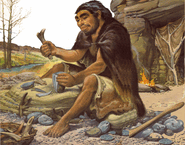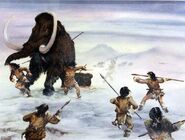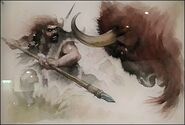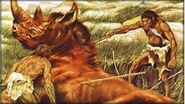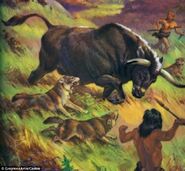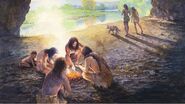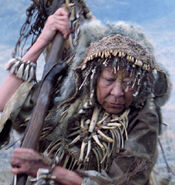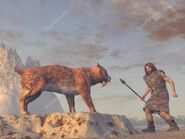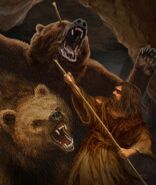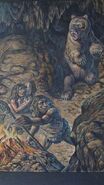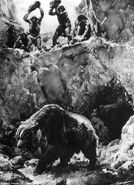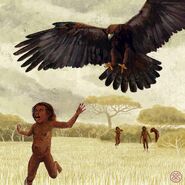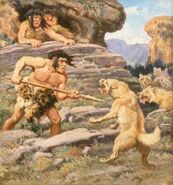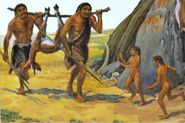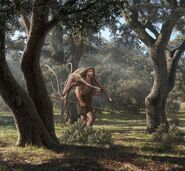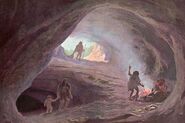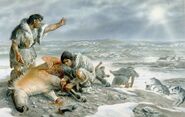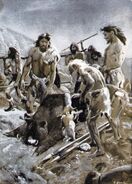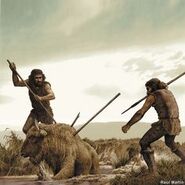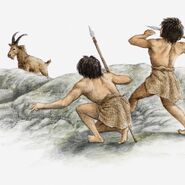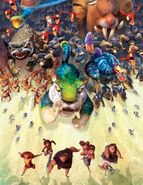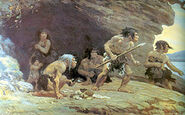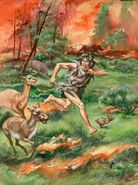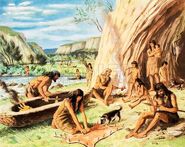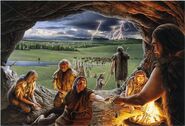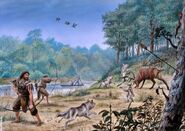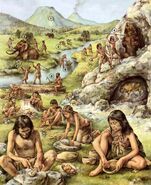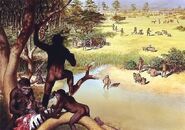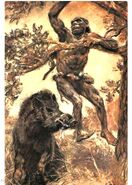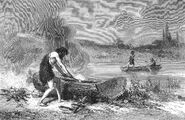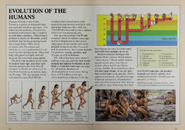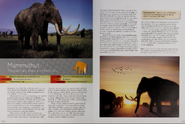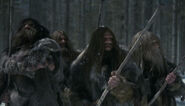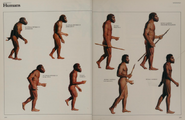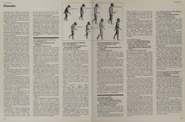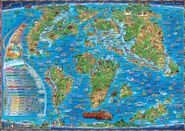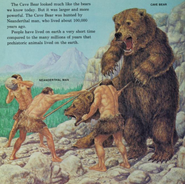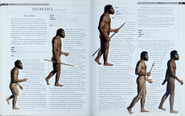| Neanderthal | |
|---|---|

| |
| Illustration by Zdenek Burian | |
| Scientific classification | |
| Kingdom: | Animalia |
| Superdivision: | Haplorhini |
| Phylum: | Chordata |
| Class: | Mammalia |
| Suborder: | Primates |
| Family: | Hominidae |
| Tribe: | Hominini |
| Genus: | Homo |
| Species: | H. neanderthalensis |
| Binomial name | |
| Homo neanderthalensis King, 1864 | |
| Synonyms | |
| |
Neanderthals or Neandertals are an extinct genus or species of humans (genus Homo), which became extinct around 40,000 years ago. They were closely related to extant humans (Homo Sapiens Sapiens), sharing 99.7% of DNA, and are a sister lineage to the Denisovans. Remains left by Neanderthals include bone and stone tools, which are found in Eurasia, from Western Europe to Central and Northern Asia. Neanderthals are generally classified by palaeontologists as the species Homo neanderthalensis, having separated from the Homo sapiens lineage 600,000 years ago, but a minority consider them to be a subspecies of Homo sapiens (Homo sapiens neanderthalensis).
Several cultural assemblages have been linked to the Neanderthals in Europe. The earliest, the Mousterian stone tool culture, dates to about 160,000 years ago. Late Mousterian artifacts were found in Gorham's Cave on the south-facing coast of Gibraltar. They also made a glue from pitch and made art and simple carvings.
Compared to Homo sapiens, Neanderthals had a lower surface-to-volume ratio, with shorter legs and a bigger body in conformance with Bergmann's rule, as an energy-loss reduction adaptation to life in a high-latitude (i.e. seasonally cold) climate. Their average cranial capacity of 1600 cm3 was notably larger than the 1250 – 1400 cm 3 average for modern humans. Males stood 164–168 cm (65–66 in) and females 152–156 cm (60–61 in) tall.
The Neanderthal genome project published papers in 2010 and 2014 stating that Neanderthals contributed to the DNA of modern humans, including most humans outside sub-Saharan Africa, as well as a few sub-Saharan Africa's populations, through interbreeding, likely between 50,000 and 60,000 years ago. Recent studies also show that a few Neanderthals began mating with ancestors of modern humans long before the large "out of Africa migration" of the present day non-Africans, as early as 100,000 years ago. In 2016, research indicated that modern humans had three distinct interbreeding events with Neanderthals: the first encounter involved the ancestors of all non-African modern humans, probably soon after leaving Africa; the second, after the ancestral Melanesian group had branched off (and subsequently had a unique breeding event with Denisovans); and the third, involving the ancestors of East Asians only.
In December 2013, researchers reported evidence that Neanderthals practiced burial behaviour and intentionally buried their dead. In addition, scientists reported having sequenced the entire genome of a Neanderthal for the first time. The genome was extracted from the toe bone of a 50,000-year-old Neanderthal found in a Siberian cave. In 2016, elaborate constructions of rings of broken stalagmites made by early Neanderthals around 176,000 years ago were discovered 336 m (1,102 ft) inside Bruniquel Cave in south-western France. This would have required a more advanced social structure than previously known for Neanderthals. Indeed, it is thought that they are our intellectual equivalents, much different from their initial image of being subhuman "ape-men". More evidence point out that the Neanderthals could practice much more 'human' behaviour than previously thought, as a study found out the species even practiced primitive form of oral hygiene with toothpicks.[1][2][3][4]
Description[]
The Neanderthals from Sidrón Cave are known to have lived not long before the Neanderthal extinction event, showing signs of starvation and they themselves were cannibalized by other Neanderthals. It is thought that the Neanderthals of this time had difficulty gathering food, and since they require more food, and in turn, calories than Homo sapiens, groups had to compete with each other. This likely resulted in both antagonistic behaviours between Neanderthal groups and even interspecific competition with certain Human (H. Sapiens) groups.[5]
Behavior[]
Neandertals lived in social groups of between 10 and 30 people, mostly relatives, made up of a mixture of adults and children. They appear to be very violent, specially when compared to other hominins. Several analysis have revealed them to posses a large level muscle mass, possibly as an adaptation for combat. Fossils of several skulls of Neanderthals reveal them to posses wounds from combat, likely as a result of fighting. Evidence also found that Neanderthals engaged in direct combat with their prey, as opposed to other anthropoid species which chase their prey from long distances to later finish them off. This suggests that Neanderthals developed a high muscle mass not just for combat but also to take damage from other animals.
Other Wikis[]
https://prehistoric-wiki.fandom.com/wiki/Neanderthal
In popular culture[]
- The Neanderthal appeared in Walking with Beasts.
- They also appeared in Walking with Cavemen.
- A Neanderthal family appeared on Before We Ruled the Earth.
- A Neanderthal man and woman appeared in an episode of Futurama.
- Laaa from Night at the museum is a Neanderthal.
Gallery[]
References[]
- ↑ https://www.smithsonianmag.com/smart-news/neanderthals-used-toothpicks-treat-aching-teeth-180963883/
- ↑ https://www.nationalgeographic.com/science/article/neanderthal-gums-relieved-by-toothpicks
- ↑ https://www.futurity.org/neanderthal-teeth-prehistoric-dentistry-1472642/
- ↑ http://www.sci-news.com/archaeology/neanderthal-toothpicks-09497.html
- ↑ https://www.youtube.com/watch?v=a6d3uHSFxkM
